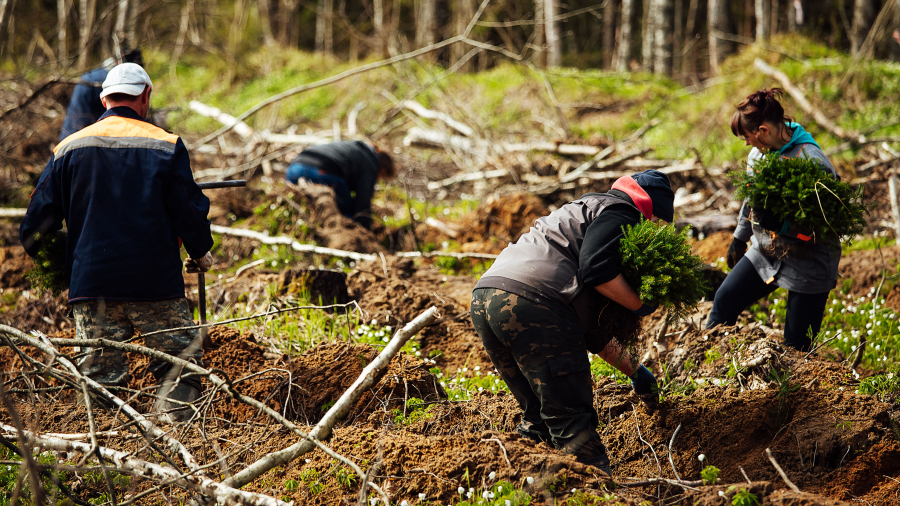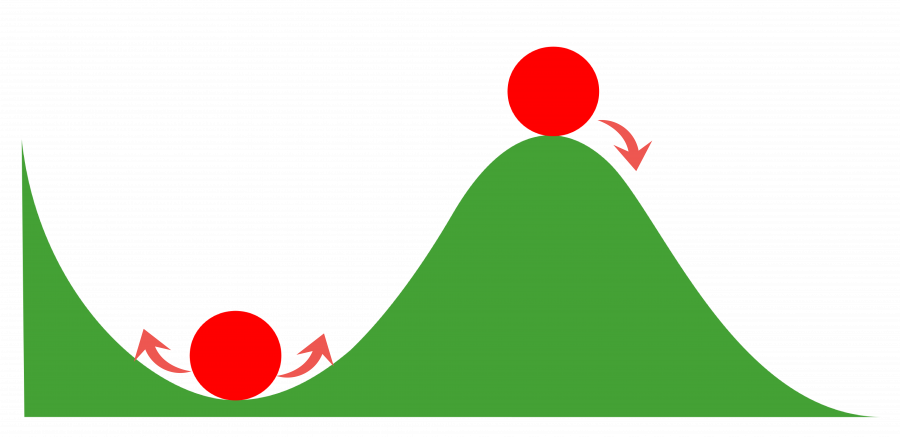
To view in your browser and/or download the article, click on the PDF below.
Resilience is the ability to withstand or recover from a disturbance and thus implies a starting state or dynamic equilibrium of a system that is altered by some disturbance (Figure 1) e.g., a physical, ecological, or social event such as storms, arrival of invasive species, economic downturns, social movements, etc. Theories of resilience assume there are system processes in place that confer resistance to or recovery from system alteration although it does not necessarily mean that the system returns to the same previous state. Such processes could include the ability of wetlands to absorb storm surges and slow wind energy, thereby protecting adjacent ecosystems (ecological resistance) or the availability of funds that help people who have lost homes or livelihoods (socioeconomic resilience).

The origins of resilience thinking arose from the physical sciences and Isaac Newton’s laws of motion, in which the state of an object (at rest or in motion) doesn’t change unless there is an external force, and displacements from a state produce forces that tend to oppose that displacement. In engineering, resilience is the ability of a material like rubber to absorb energy if struck and then release that energy as it springs back to its shape. But today, resilience has applications in almost all disciplinary domains—psychology, economics, organizational science, health care, chemistry, and more.
The Resilience Concept for Socio-Environmental Systems
Crawford Holling1 first applied resilience to ecological systems in 1973, and now ecologists use it almost routinely. Ecologists operationally define resilience as the magnitude of disturbance that a system can absorb before it flips to another state. They have linked resilience to theories of species diversity, adaptation and evolution, ecosystem restoration, conservation and management, ecosystem productivity, population dynamics, extinction risk, and much more.2, 3, 4, 5 In general, the assumption is that diversity in any form—genetic, species, physical heterogeneity—enhances ecological resilience.
Social resilience is the ability to cope with disturbances that result from social, political, environmental, and other forms of change. Researchers have applied social resilience to issues of physical and mental health in the context of disease, domestic abuse, and poverty and to issues of community response to storms, economic shocks, and conflict.6, 7, 8 Social resilience varies by economic, race, and social status, largely due to differences in access to resources. Much like biological diversity and its link to ecological resilience, studies have shown that social resilience is higher when there are diverse social networks, varying sources of income or economic assets, and diverse skills and abilities possessed by citizens.9, 10
Research on what confers socio-environmental system resilience is growing constantly. Some of this research focuses on the role of social processes in conferring resilience e.g., the sharing of natural resources among Indigenous subsistence fishing communities in the Arctic.11 Other studies focus on environmental features that enhance resilience such as connectivity in the context of landscape ecology.12 Increasingly, studies are considering how ecological and social processes together have the potential to enhance or reduce socio-environmental resilience. 13, 14
Many scholars view socio-environmental resilience as a “reorganization” process that occurs in response to a major social or environmental disturbance. As described in the SESYNC explainer Socio-Environmental System Change and Reorganization, this theory asserts that S-E systems move through a series of identifiable states that are governed by processes operating at different temporal and spatial scales.
References:
1 Holling, C.S. (1973). Resilience and stability of ecological systems. Annual Review of Ecology and Systematics, 4, .1-23. https://www.annualreviews.org/doi/epdf/10.1146/annurev.es.04.110173.000245
2 Chambers, J.C., Allen, C.R., & Cushman, S.A. (2019). Operationalizing ecological resilience concepts for managing species and ecosystems at risk. Frontiers in Ecology and Evolution 7: 241. https://doi.org/10.3389/fevo.2019.00241
3 Donaldson, L., Bennie, J.J., Wilson, R.J., & Maclean, I.M. (2019). Quantifying resistance and resilience to local extinction for conservation prioritization. Ecological Applications, 29(8): e01989. https://doi.org/10.1002/eap.1989
4 Zabin, C.J., Jurgens, L.J., Bible, J.M., Patten, M.V., Chang, A.L., Grosholz, E.D., & Boyer, K.E. (2022). Increasing the resilience of ecological restoration to extreme climatic events. Frontiers in Ecology & the Environment, 20(5), 310-318. https://doi.org/10.1002/fee.2471
5 Machado‐Silva, F., Peres, L.F., Gouveia, C.M., Enrich‐Prast, A., Peixoto, R.B., Pereira, J.M., Marotta, H., Fernandes, P. J., & Libonati, R. (2021). Drought resilience debt drives NPP decline in the Amazon Forest. Global Biogeochemical Cycles, 35(9), p.e2021GB007004. https://doi.org/10.1029/2021GB007004
6 Barrett, C.B., & Constas, M.A. (2014). Toward a theory of resilience for international development applications. Proceedings of the National Academy of Sciences, 111(40), 14625-14630. https://doi.org/10.1073/pnas.1320880111
7Archer, D., Marome, W., Natakun, B., Mabangyang, P., & Phanthuwongpakdee, N. (2020). The role of collective and individual assets in building urban community resilience. International Journal of Urban Sustainable Development 12(2), 169-186. https://doi.org/10.1080/19463138.2019.1671425
8 Alizadeh, H., & Sharifi, A. (2022). Social Resilience Promotion Factors during the COVID-19 Pandemic: Insights from Urmia, Iran. Urban Science 6(1), 14. https://doi.org/10.3390/urbansci6010014
9 Grêt-Regamey, A., Huber, S.H., & Huber, R. (2019). Actors’ diversity and the resilience of social-ecological systems to global change. Nature Sustainability, 2(4): 290-297. https://doi.org/10.1038/s41893-019-0236-z
10 Pfefferbaum, B., Van Horn, R.L., & Pfefferbaum, R.L. (2017). A conceptual framework to enhance community resilience using social capital. Clinical Social Work Journal, 45(2), 102-110. https://doi.org/10.1007/s10615-015-0556-z
11 Scaggs, S.A., Gerkey, D., & McLaughlin, K.R. (2021). Linking subsistence harvest diversity & productivity to adaptive capacity in an Alaskan food sharing network. American Journal of Human Biology 33(4), 23573. https://doi.org/10.1002/ajhb.23573
12 Butler, E.P., Bliss-Ketchum, L.L., de Rivera, C.E., Dissanayake, S., Hardy, C.L., Horn, D.A., Huffine, B., Temple, A.M., Vermeulen, M.E., & Wallace, H. (2022). Habitat, geophysical, and eco-social connectivity: benefits of resilient socio–ecological landscapes. Landscape Ecology 37(1), 1-29. https://doi.org/10.1007/s10980-021-01339-y
13 Kattel, G.R. (2020). Are freshwater systems in lower Mekong basin (southeast Asia) resilient? A synthesis of social-ecological system. Environmental Research Communications 2(11), 115004. https://doi.org/10.1088/2515-7620/abcca9
14 Kliem, L., & Sievers-Glotzbach, S. (2022). Seeds of resilience: The contribution of commons-based plant breeding and seed production to the social-ecological resilience of the agricultural sector. International Journal of Agricultural Sustainability 20(4), 595- 614. https://doi.org/10.1080/14735903.2021.1963598